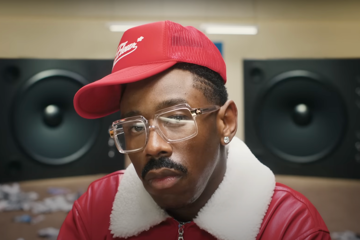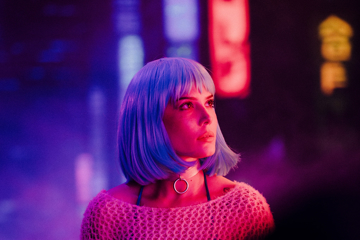Film Carew
'Upstream Color' is one of the few films in 2013 to get lost within.
In 2004, Shane Carruth arrived with a Primer, an effectively 'home-made' science-fiction think-piece that, though poor in budget, was rich in ideas. It turned the hoary conceit of time-travel into something both graspable - the end result of a period of egghead-ish, jargon-rich R&D - and philosophical; with its narrative slips provoking more in the imagination of viewers than most big-budget special-effects-orgy ever will. A more generic filmmaker would've taken Primer's critical reputation and ideas-rich promise and used it as a Hollywood calling-card; would've indeed gone off and helmed their own big-budget special-effects-orgy. But Carruth isn't your run-of-the-mill filmmaker-for-hire. Instead he functions with a singularity that's more reminiscent of an indie-musician, helming every aspect of productions himself: writing, directing, acting, composing, editing, producing, even distributing. When other filmmakers employ such 'renaissance-man' shtick, it's usually an exercise in ego - Vincent Gallo leaps to mind - but Carruth seems too earnest to be so diagnosed; instead, preserving his singularity of vision is his working way, the tools of the digital filmmaking era merely offering that level of finicky control.
Which leads us to Upstream Color, Carruth's long-time-coming second feature (and, yes, the local release is going with the American spelling; welcome to the globalised (or, indeed, globalized) world). His ponderous, wafty, thriller-in-the-body-of-an-abstract-art-movie features the kind of highly-interpretive narrative that no major-studio suit would ever sign off on. It stars Carruth and fellow filmmaker Amy Seimetz as a couple who meet-uncute on a train - over and over again - and seem mystically connected to each other; and, for that matter, to a bunch of pigs on a farm tended to by a middle-aged, cardigan clad field-recording enthusiast (Andrew Sensenig). It turns out they're both survivors of a haute-philosophical form of new-millennial abuse: victims of a 'thief' (Thiago Martins), who, in the pirouette past of flashbacks, drugs them with a parasite harvested from worms that grow in the roots of a rare orchid; a parasite that the pig-farmer takes from humans and transfers into his stock, all whilst making local-run CDs of contact-mic-sourced drone.
But putting such a plot into words is a form of prosaic reduction for what is a poetic picture. If Primer felt more like the new-millennial spawn of old Twilight Zone episodes, here the artistic progenitor is clearly Terrence Malick: Carruth's film filled with shots from a camera in balletic motion, all bleeding light and images of water (life, as ever, an everflowing stream), an impressionist mosaic built from artful photography. There's not the same sense of sunny warmth as in Malick's films, but that is intentional; the wan colour (or, indeed, color) palette, cold digital edges, buzzing fluorescent lights, and perpetually cloudy skies suggesting its philosophical differences. Malick's divine cinema is, in its own way, about God; Upstream Color is a film about playing God. It sets the cycle of abuse against the cycle of life, and sees how an unnatural incursion - either man turning parasite into drug, or man abducting woman from nightclub - can disrupt the order of things. In conversation, Carruth denies that his film has a single genesis story: that there's one idea, one seed of inspiration at its core. Instead, he believes that the film is about many ideas growing together, feeding off each other; in short, even Upstream Color's back-story suggests a belief in eco-systems, not creation myths. His film doesn't have a straight narrative because neither does the natural world.
This means that, for a certain kind of viewer, Carruth's second feature will be the greatest of joys: an American film that not only doesn't pander to its audience, but makes demands of it; that, in many ways, puts the interpretive burden in their hands. It isn't a piece of pure cinema, in that Malickian way, but it's a definite tone-poem; the seeming limits of the cast - all pleasingly unfamiliar faces, yet often seeming like their turns're mundane; that they're strolling, coldly, through a world of restless montage and chin-scratching philosophising - matter little given that Carruth is making a film whose narrative remains open; whose small picture suggests thoughts on the bigger picture. Subsequent viewings flatten its wonder a little; and if the moment-of-vengeance finale isn't a critique of attempting to find closure through killing, then it's terribly judged. But the joys of watching Upstream Color for the first time, especially if you don't know what you're getting into, shouldn't be undersold. Few films in 2013 offer the view such a wonderful opportunity to 'get lost' within.
Don't miss a beat with our FREE daily newsletter
There's a great scene in What Maisie Knew in which the six-year-old titular character (played by screen debutante Onata Aprile) wakes up in the dark. She's been passed from parent to parent, step-parent to step-parent, random co-worker to, well, no idea. As she tiptoes out of the darkness, we have no idea where she is, and what'll she see. It's a poignant scene that distils the theme of the whole: directors Scott McGehee and David Siegel out to show divorce from the perspective of a child caught in the middle. Taking Henry James's so-named fin-de-siècle novel as its starting point, What Maisie Knew is a portrait of, essentially, the celebrity childhood: Aprile ricocheting between a rockstar mother (Julianne Moore) and art-dealer father (Steve Coogan), a pair of self-obsessed narcissists whose only affection for their child is when she serves as reflection of themselves. McGehee and Siegel - dudes who, though they've never good on the two-decades-ago promise of the strange Suture, have still etched out an interesting career on the prestige-picture fringes - aren't interested in demonising either of the wayward parents; only using the vantage of a child's view to show their drama from a different perspective. Here, when parents fight, go to court, passively-aggressively manipulate each other using their spawn as a pawn, or disappear then reappear at random, we feel the weight of this flux, and the terror of uncertainty; it never feeling more uncertain than when we wake up in the dark, in the unknown.







